Introduction
A bee did not have to go far from its bee colony not so long ago. Flowers and honey plants were everywhere nearby. Today, a bee has to travel long distances to find the best flowers for bees.
What is the reason for this? First of all, the number of inhabitants on the planet has grown a lot, and thus the need for more food and space. Where there used to be meadows, there are now fields of corn, wheat or increasingly residential buildings. Also, the use of pesticides in the cultivation of all agricultural crops is increasing and the number of forests is decreasing.
We can provide bees with pasture by sowing plants that they like to visit. For beekeepers, sowing honey plants also brings some security.
Of course, sowing honey plants requires a great deal of human labor, resources and arable land. Even if you don’t own bees, you can contribute to their preservation by planting your favorite bee flowers.
What are honey plants?
Honey plants are all those plants that bees use to make honey.
Honey plants are of great importance in beekeeping. They can significantly contribute to stronger bee colonies and more economical beekeeping.
Within one plant community, certain types of plants or certain plants, in a certain period of time, with their abundant flowering and honey, can attract a lot of bees from their environment.
This does not disturb the community in any way, but such a plant at that time only dominates over other plants.
If the concentration of honey plants is insufficient near the beehives, or when the honey harvest is diminished due to unfavorable weather conditions, beekeepers move the hives in search of fertile places. Additionally, in order to ensure a continuous honey harvesting process and improve the quantity and quality of products around the apiary, honey plants with different flowering times are planted.
Nature has endowed flowers with beautiful colors to attract pollinators. It has been discovered that bees prefer the spectrum of yellow, white, blue or purple colors.
Best Flowers for Bees
The story of how endangered bees are is already known, but the ideas of solving this problem are never ending. I recently came across an idea that was shared on Pinterest. This is an interesting graphic, entitled “Save the bees by growing these plants”, which additionally motivated me to research and write an article in which I will present the best flowers for bees.
Surely there is a place in your environment where you can plant some of the plants that are of great importance to our little friends. A bee can fly a distance of up to eight kilometers, so if you plant bee flowers on your balcony or window, in a small garden, some bees will surely reach it.
In addition to honey, which is very important to us, bees provide us with much more – they enable us to live by pollinating plants. Every time you eat a fruit or vegetable, remember that it is in your hands thanks to the bees.
If you want to know which the best flowers for bees are, don’t miss this article in which I show you the best plants and flowers that attract bees.
1. Phacelia
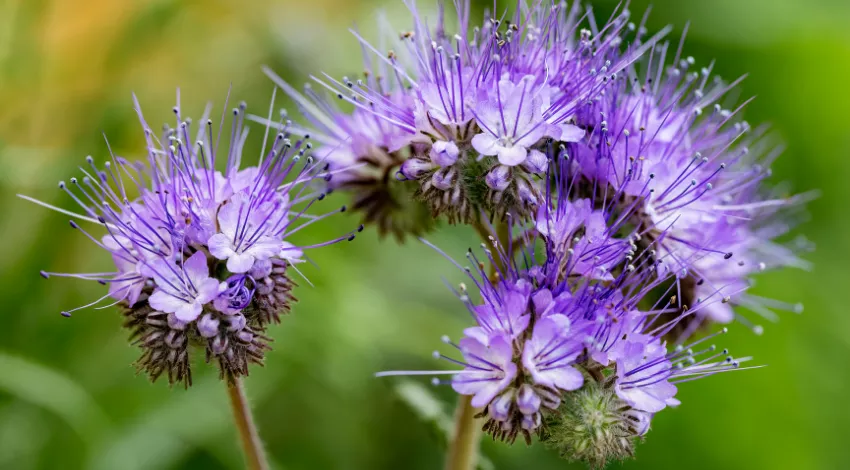
Phacelia, a favorite flower of bees, is a year-round plant whose flowers give high yields of nectar. One can collect 500-1,000 kg / ha of honey, depending on sowing, weather conditions and the length of the day. It is originally from America and was introduced to Europe in the early 19th century.
On each branch we find twigs that bear tiny flowers. The petals are purple at the top and turn white at the bottom. One plant contains from 5,000 to 7,000 flowers.
It tolerates almost all soil types, although it thrives best on lighter soils. However, due to the small seeds it requires very well prepared soil for sowing.
Phacelia can be sown at any time of the year if the weather is favorable and the soil is properly prepared for sowing. However, we usually sow it from February to May, and if the weather is wet, in June as well.
It is best to sow during March, because at that time there is enough moisture in the soil and intensive weed growth is not significant. Bees will be able to use what was sown for grazing at that time.
2. Lavender
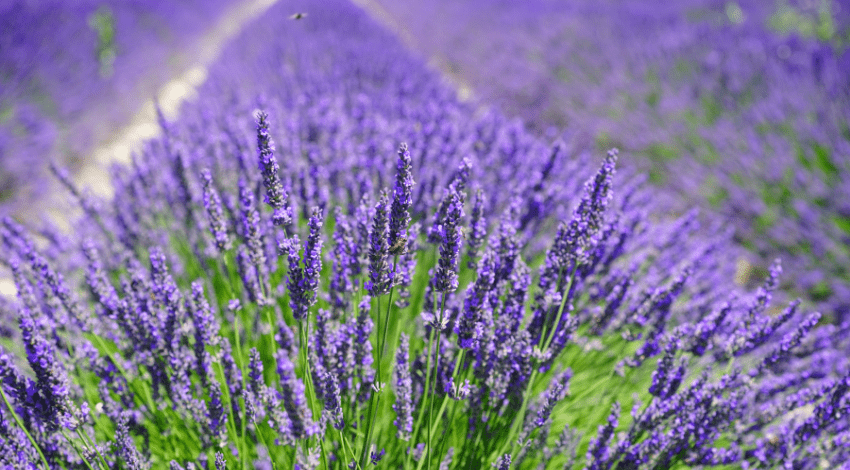
Many beekeepers will agree that lavender is the least demanding to grow, and with it the favorite flowers of bees.
The beautiful purple flower and intoxicating scent will primarily attract bees, and also serves as a good pasture. So, its shrub will come in handy in any garden because it will increase biodiversity, attract bees and bumblebees, but also delight you with its color and scent.
Lavender is a phytonicidal plant that prevents the appearance of aphids and ants. Its lifespan can reach up to 30 years.
True lavender is most often propagated by seedlings obtained from seeds, but it can also be propagated vegetatively, by green seedlings and clones. Hybrid lavender is propagated only vegetatively because the seeds are sterile.
All seedlings are planted in the fall, during October. Planting in the spring is not recommended, and the deadline for successful planting is March.
When it is well soaked before flowering and constantly served by nice weather, it can yield 50 kg of honey per hive. Daily yields range up to 6 kg. In weaker years, lavender yields 10-15 kg of honey per hive, while there is no information about years when nothing is yielded.
3. Sage

Sage and bees are made for each other. Their small flowers hold enough nectar to attract all the bees nearby.
Sage is very resistant to long-term droughts, but in order for nectar to flow from its flowers, moisture is absolutely necessary.
It blooms from May to late July. Up to 500 kg of honey can be obtained from one hectare. The flowers are rich in nectar and are an excellent grazing.
Sage honey is refreshing, due to the high percentage of vitamin C. It can be both light and dark in color, and is almost always used in many ailment treatments.
Sage honey yields are the best when the weather is warm with plenty of moisture in the air. After its flowering, a dry period usually begins, when the bees are dormant. They should be left with enough honey in the hive for this period.
4. Gaillardia
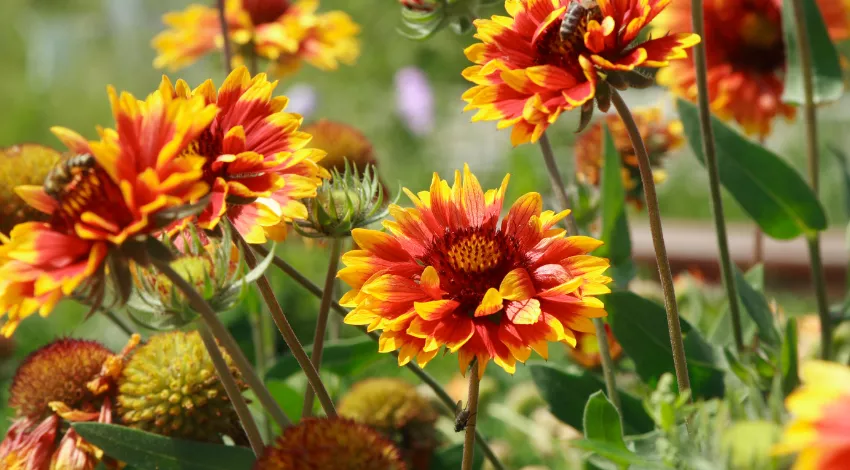
These hardy plants with a large number of flowers provide large amounts of food for bees and thrive best in suitable climatic conditions. They develop most easily from seeds, and flowering lasts from early summer until autumn.
Striking flowers grow in yellow, orange and burgundy colors and can often be found with colorful petals. Plant them in a dry and sunny place in the rock soil, and regularly remove dead flowers to keep the plant healthy.
5. Aster
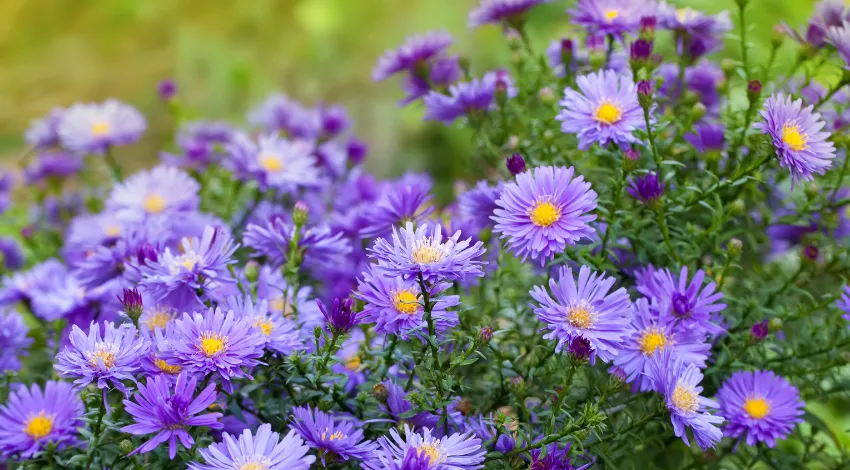
Aster is a plant that mainly blooms in September. The vast majority of plants were already in bloom at that time, so bees visit this plant a lot and collect nectar and pollen. The aster’s origins are from North America. They like light, moist and drained soil and moderately fertile soil. The flower is in various shades of pink and purple.
It is easy to grow and in can be found in a wide range of colors and shades. It blooms in late summer and autumn, and provides bees with food during the later season. It provides bees with good nutrition during the winter months.
For bees, this is one of the last abundant autumn pastures. The asters are incredibly attracted to bees. As long as the weather is nice and sunny at this time of year, the asters are full of bees. There are often so many of them that everything around the asters you can literally hear buzzing.
All autumn asters are extremely resistant and tolerate frost. You don’t have to protect them over the winter. In addition, most of them are extremely invasive.
6. Rosemary
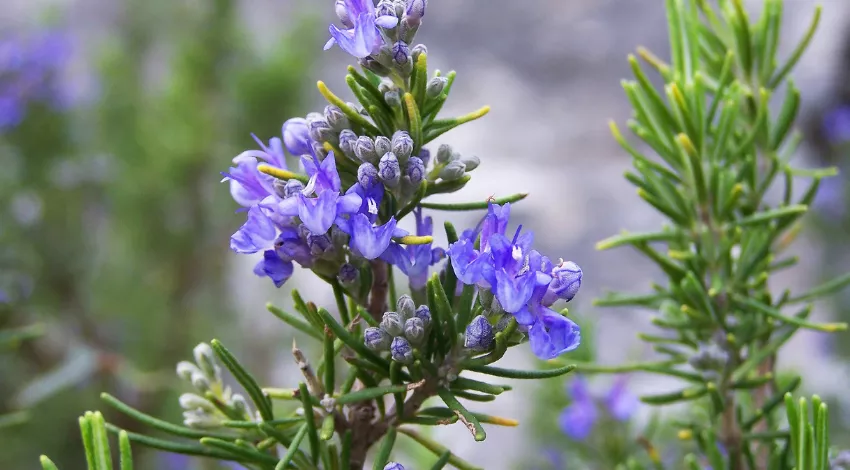
Rosemary is a shrubby, perennial, rustic plant species that reaches a height of 50 – 300 cm. It is characterized by deep roots, linear lanceolate leaves and indigo-lilac flowers. To grow best, it needs sunny positions protected from icy winds and well-drained sandy soils.
It can also be grown in pots, making sure to put debris at the bottom for optimal drainage. It is considered as one of the plants that bees love the most.
Rosemary is a high honey-yielding plant. In extremely good years, it can produce up to 60 kg of honey per hive.
Rosemary honey is bright, transparent and clear, like oil. It is odorless, pleasant and mild in taste. It crystallizes very quickly into fine tiny crystals. In the solid state it is completely white. It is one of the finest types of honey.
7. Dandelions (Taraxacum)
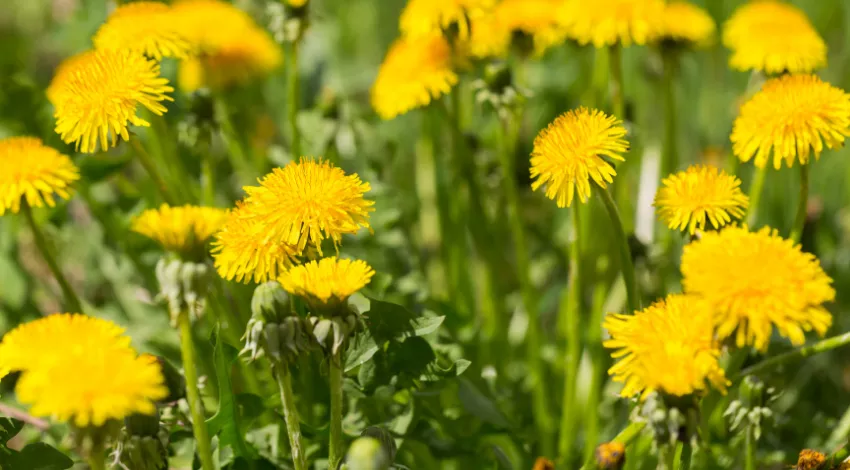
Dandelion is one of the best friends of pollinators and therefore it is recommended that you do not remove them from your garden in the spring. To help pollinators such as bees and bumblebees, allow the grass to grow to ankle height.
Dandelion is a medicinal herbaceous plant very widespread in Italy. It is found mainly in grassy and ventilated places characterized by moist soils. The leaves are simple, oblong, lanceolate and with a serrated edge.
Dandelion is easily recognizable by its intense yellow flower heads that close when the sun sets.
Flowering occurs in spring, April or May, but can be extended until September. It prefers a temperate climate even if it is not a particularly demanding plant because it can grow along roadsides. No special soil is needed to grow dandelions in pots, common soil in vegetable gardens is enough.
8. Cornflower
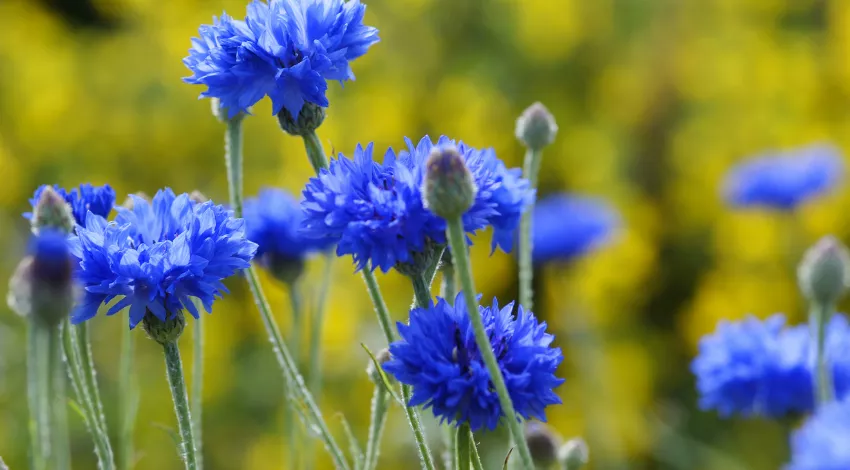
Bees and beekeepers love cornflower, which is full of flower nectar and which is often planted near apiaries. It has long been used in the natural healing of many ailments, and was named by Hippocrates himself.
It is especially popular as an ornamental plant because of its beautiful blue-colored flowers. There are white, pink and dark red types of cornflower, but violet-blue is the most widespread. It has a long stalk up to 70 cm, and blooms from June to September.
Cornflower is very easy to grow from seed at the end of winter on the window stalls, and small plants can be planted in the garden in April or May where they will spread and where you can enjoy all summer in its blue-blue color.
9. Sunflowers
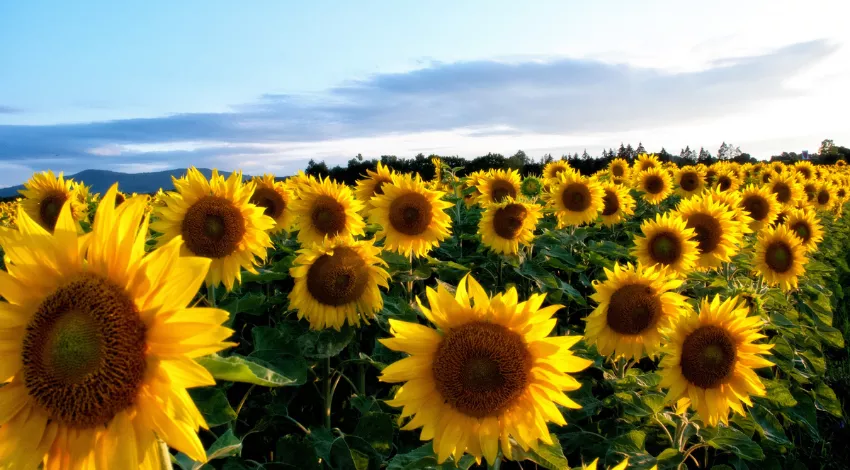
Without any prior knowledge, it can be said that sunflower is one of the best flowers for bees. Sunflower is the most important oil plant and one of the most important honey plants.
Sunflower requires deeply cultivated fertile soil. It is an annual plant with a strong root and a tree up to 2 m tall. The leaves are large and complete in shape. A yellow flower head grows on top of the tree. A well-developed head can hold up to 1,500 flowers in almost concentric circles. It begins to bloom in late June and lasts about 20 days. Bees have the largest share in sunflower pollination, thus increasing seed yield.
In the literature, it is most often mentioned that sunflower produces 40 kg of nectar and 80 kg of pollen per hectare. This amount depends on the grazing conditions. Collected honey can range from 10-15 kg / ha in bad conditions, to 50-80 kg / ha in good ones. Some sources state that sunflower can produce as much as 250 kg / ha of honey.
10. Rudbeckia – Black-eyed susan (Rudbeckia hirta)
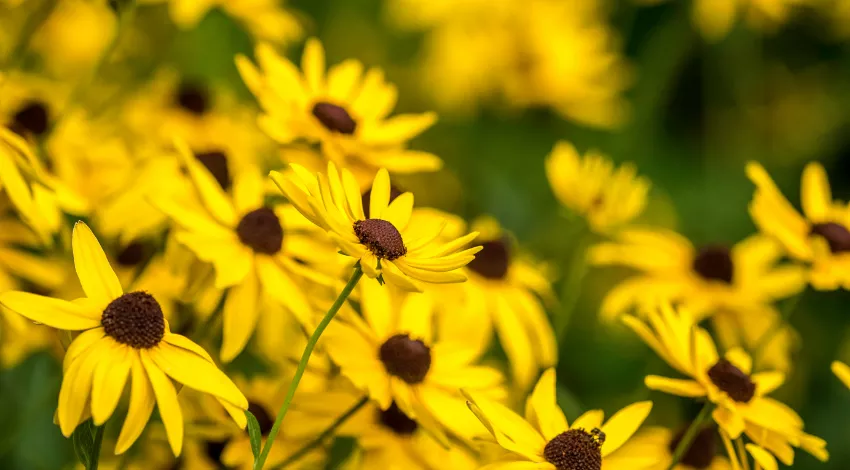
Rudbeckia is one of the most famous plants that delights us every year with its magnificent growth and color of flowers. Rudbeckia are large and beautiful plants, so it is impossible to pass by them indifferently.
The great ‘Goldstrum’ rudbeckia is a perennial plant that blooms until September. It has large flower baskets, up to 12 cm in diameter.
Originally from North America, it is very popular among bees and other pollinators.
Plants belonging to the genus Rudbeckia are not demanding. They like sunny, open places and tolerate the most permeable soils. They do not dry out in summer.
Thanks to the simple cultivation and the beautiful end result, Rudbeckia became really popular, so the breeders developed a lot of other species and varieties.
11. Beebalms
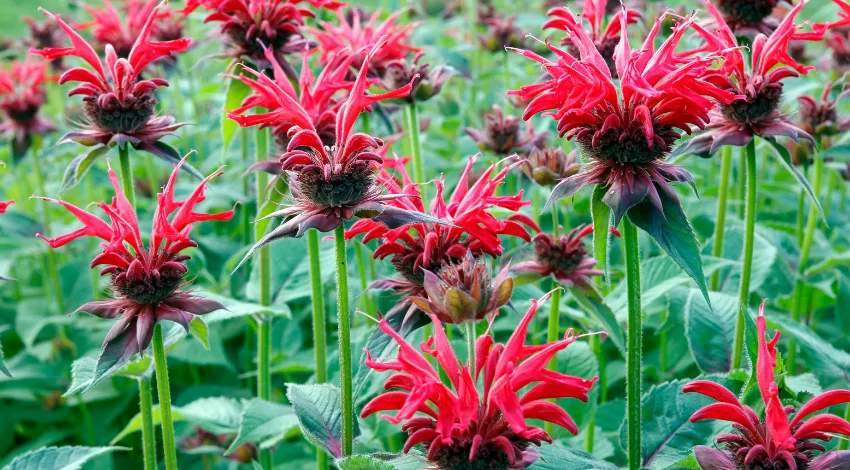
Beebalm is a very attractive plant from whose intertwined roots sprout erect and springy, hairy red-edged stems with red knees every spring.
The beebalm originates from North America, from the area around Lake Ontario, and where 12 species of annual or perennial butterflies grow wild. As a refreshing herbal drink and as a spice for game and fish, the beebalm was first used by the North American Indians.
After the beebalms was discovered by American immigrants, its seed arrived in Europe.
This indigenous plant of North America deserves a place in every bee garden because it grows without problems in almost all parts of the country, especially in summer when it begins to bloom.
12. Goldenrod (Solidago virgaurea)
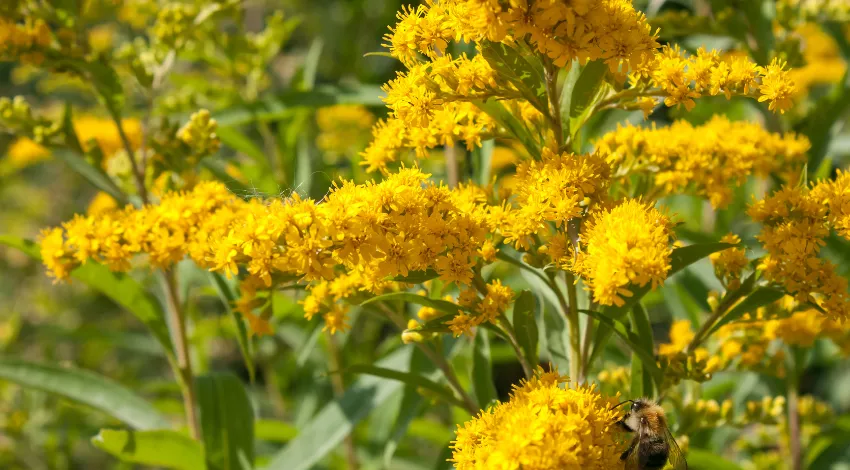
It is not uncommon to see entire swarms of bees around these herbaceous perennials that are native to the American continent. Large amounts of nectar and pollen are found in small golden-yellow flowers that bees simply cannot resist.
However, this plant is not as popular among gardeners as it should be, because many believe that it causes allergies, which is not true.
If you want to refresh your garden with a plant that will bloom regularly every year from mid-summer to mid-autumn, and beautify your garden with its golden flowers, be sure to plant a few goldenrod plants.
13. Snowdrops
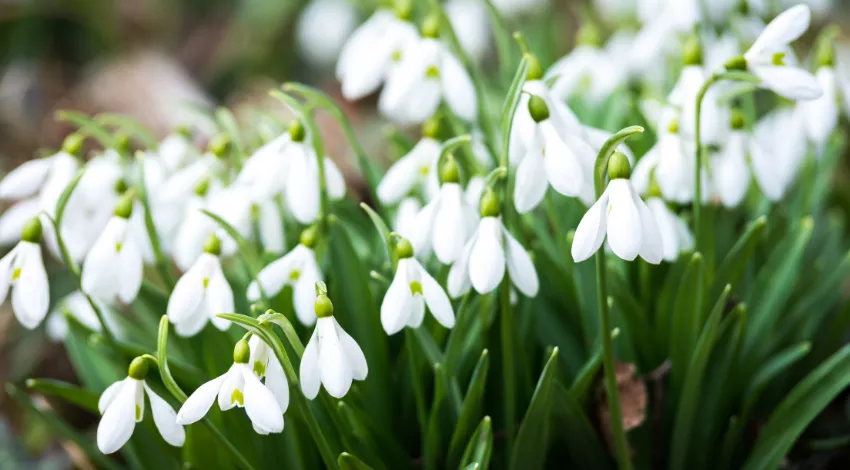
Snowdrop is a honey and pollen plant. It is the first forest, wild ground flowers that give bees both nectar and pollen in late winter-early spring. It blooms from one month up to four months. With such a long flowering period, it gives bees a constant source of nectar as well as pollen.
It grows in deciduous airy forests of sessile oak and hornbeam, mixed and evergreen forests and in meadows from lowland to mountainous areas, along rivers, in beech forests, meadows, along streams and willows.
It does not choose a habitat, it is very modest in choosing the soil on which it grows, so it is an ambiguous useful plant that needs to be nurtured and preserved in its natural environment.
14. Saffron

Saffron is known as the most expensive spice in the world. The short season blooms – only three weeks a year, as well as hard harvesting and a long production process make it more expensive than all other spices.
Saffron has a bell-shaped flower, with six petals, a yellow pistil and three yellow anthers. The leaves of saffron are long, narrow, not toothed, dark green with a recognizable white division – a line along the leaves. It likes a sunny or semi-shady position, and rich and moist soil. It is propagated by dividing the bulb seeds in the fall.
Saffron is a honey-bearing and pollen-bearing plant, which provides bees with larger amounts of pollen in this sensitive season “neither winter nor spring”, so in beehives for a few days with nice weather you can find quite a large intake of this bee “bread”. It gives less nectar, almost insignificantly, but it is enough for the first spring development and movement of the brood in the bee colony…
Saffron loves bright airy forests and glades; the flower opens in the morning and closes in the evening. It is very delicate and if the day is cloudy without sun, the flowers will not open.
15. Violet

Violet is a favorite flowering plant of early spring, which with its distinctive and strong scent reminds us of our first steps in nature.
It is a perennial plant, but there are also subfamilies that are annuals. It grows on forest glades and clearings, among bushes, in shady places and along forest edges, along streams, river banks, in gardens, fields, in thickets and hedges.
It is a honey-full and pollen bearing plant that gives bees more nectar and less pollen in the earliest spring. Bees like to visit it.
Violet is a flowering plant with a distinctive, pleasant scent, as its name suggests. That is why many people like to grow it in gardens in many varieties. Some species are grown for their ornamental flowers in the corners of gardens and in rock gardens.
16. Vanilla Shrub (Heliotropium)
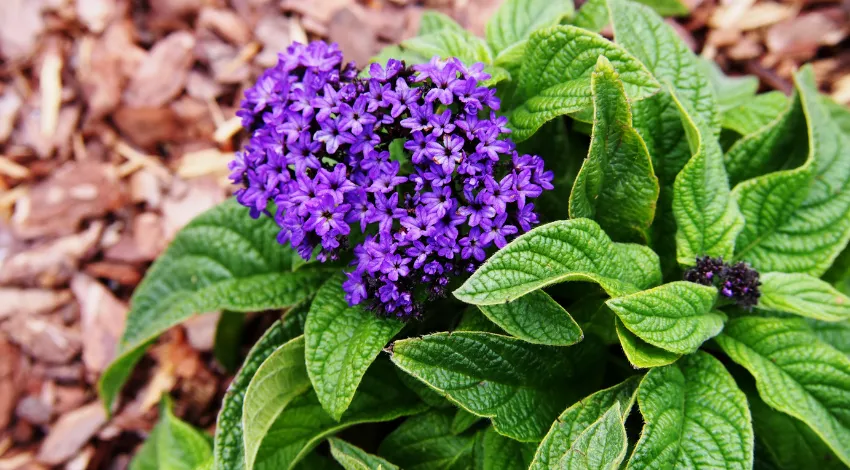
Heliotrope, better known as vanilla shrub, has tiny flowers that smell of vanilla and are most often purple to dark blue in color, and less often pink or white.
It originates from Peru, where it grows in tropical and subtropical forests. In its natural habitat, it can grow up to 100 cm in height, and depending on the variety grown, 30 to 60 cm. It is a densely branched, bushy plant with long, broad, oval, dark green leaves, pronounced ribs. The leaves are rough and densely hairy. It blooms from mid-May to late October and its flowers attract bees, butterflies and birds. It can be grown in the garden, but also as a houseplant.
The pleasant scent of flowers makes them a good choice for planting next to a place to sit and relax.
17. Catnip (Nepeta cataria)
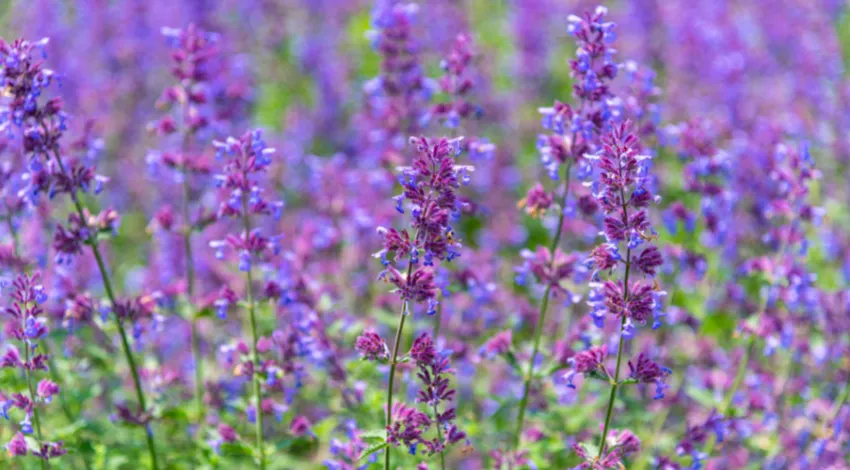
Catnip is a perennial plant that is easy to grow and does not require much treatment. It grows well in any soil, especially in sunny and dry places. Cats and bees are equally crazy about this fragrant plant that blooms in summer and fall.
The flowers can be pink, blue, purple or white.
Taste, ease of cultivation, medicinal properties and the fact that it is great for bees, makes catnip one of the most popular garden plants.
18. Oilseed rape (Rapeseed)
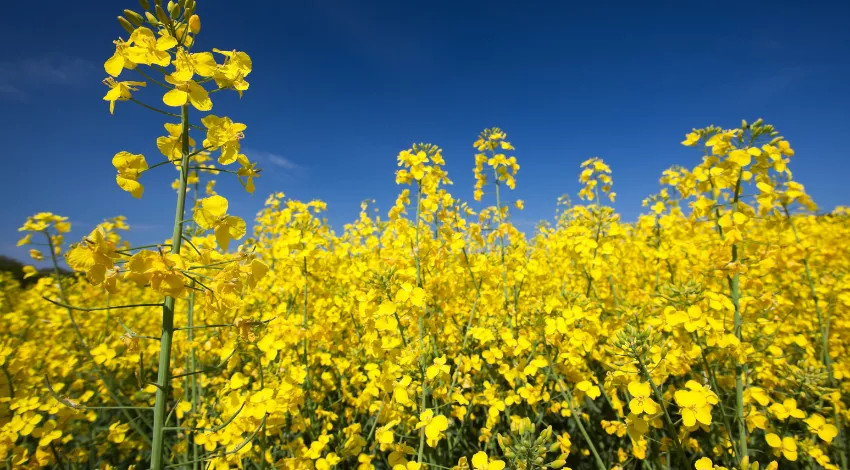
Oilseed rape is grown as animal food and for oil production. Its yield can be significantly increased by bees, which have the role of pollinators.
It thrives best in moderately warm and moderately humid areas. Oilseed rape is a long day plant; it needs a lot of light which can be provided by a good and proper assembly and arrangement of plants. It has a great need for water. Most water is needed during times of intense growth. The soil should be fertile, have good structures and have good water-air properties.
It is an interesting honey plant because it is rich in nectar, flowering lasts about twenty days, and blooms in April when there is almost no other bee grazing.
Due to the above-mentioned, it has a significant role in the spring development of bee communities. Under favorable conditions, 10 to 20 kg of honey per hive can be produced by oilseed rape grazing.
19. Buckwheat
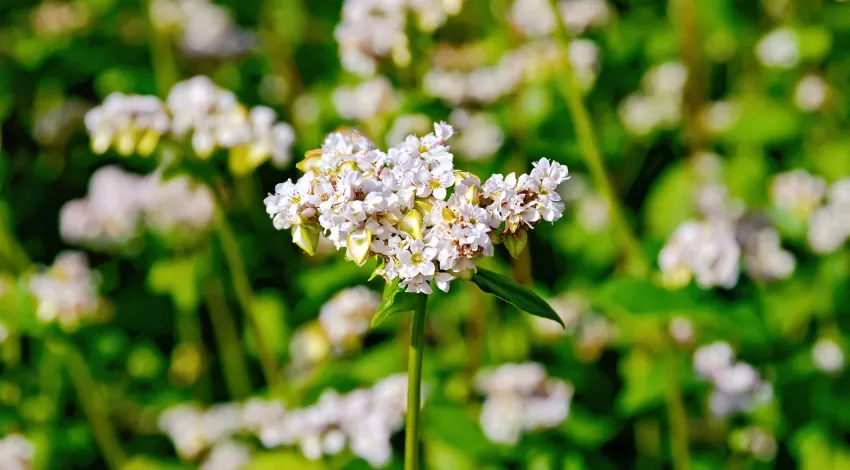
Buckwheat is a well-known and somewhat forgotten pseudo-cereal of great nutritional value. It is resistant to severe climatic conditions, with no pests, ideal for organic farming.
It thrives successfully at higher altitudes where it is grown as the main crop, while in lower areas it is a post-harvest crop. It forms a branched tree up to 120 cm high. White flowers, the number of which reaches up to 2000, can be freely classified as a favorite bee flower.
Buckwheat is a pollen plant that, in addition to being useful for bees, is also useful for human health. It is rich in iron, phosphorus and iodine; it contains a lot of vitamins.
Due to the long flowering period (60 days), the bees have a very long grazing. Bees increase the fertilization of buckwheat flowers, thus achieving a higher yield of buckwheat, as much as 50% yield compared to those without bees.
Buckwheat honey is of exceptional quality and highly respected due to its high content of vitamin D. The yield of honey can be up to 90 kg / ha. The flowers also attract beneficial insects (parasitic wasps, ladybugs, hay flies, predatory bed bugs).
20. Calendula
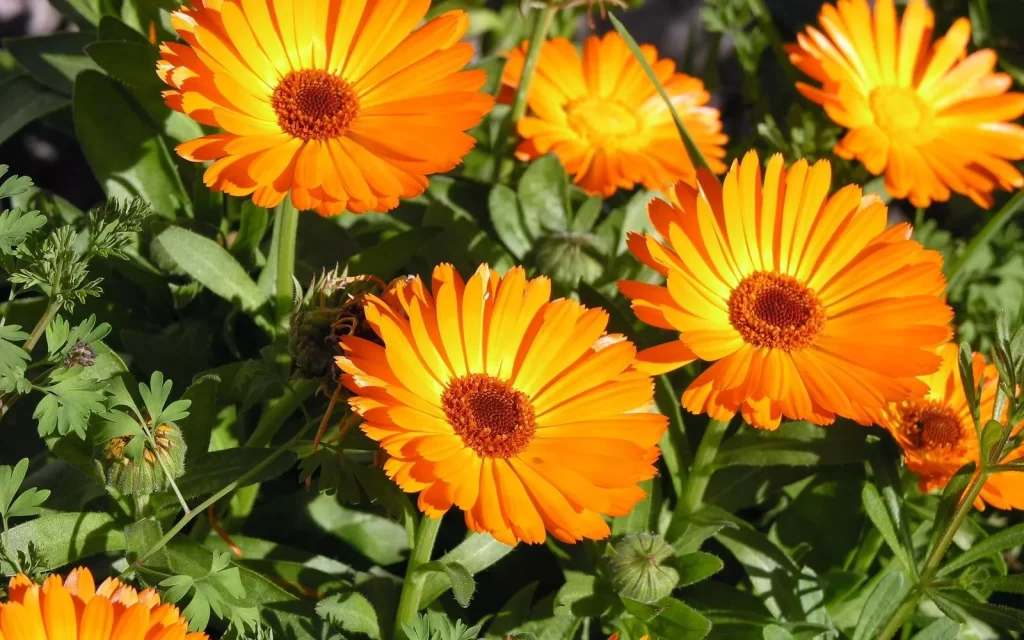
The medicinal properties of calendula are known to many people, but calendula is also a honey plant. In addition to nectar, it also produces pollen. It blooms from June to October, which is especially important for bees because at that time of year they have hard time finding pollen. Where there are calendula, beekeepers will notice an increased amount of pollen at the legs of their bees at that time.
Calendula is one of the best flowers for bees because of its strong antioxidant properties, which has a positive effect on the health of the bee colony.
Calendula can be found in nature along roads, along forests, on the edges of arable fields, on sunny meadows. When it comes to plantation production, it is quite simple. No expensive mechanization is needed; most of the work is done by hand. Sowing begins in March, if spring is normal. It is planted in rows at a distance of half a meter and about 20 centimeters from plant to plant.
For beekeepers that practice growing honey plants in the immediate vicinity of their beehives, calendula is a very good choice.
END
We know that many people are afraid of these valuable little insects, but their mission is not to be a nuisance, but to collect nectar, and to pollinate flowers and plants. And when they collect nectar, bees can produce honey and most importantly, they continue to maintain their species. Therefore, you have nothing to fear, but plant your favorite bee flowers that will captivate both your heart and the heart of the bees.
